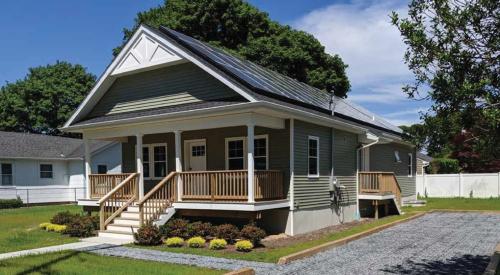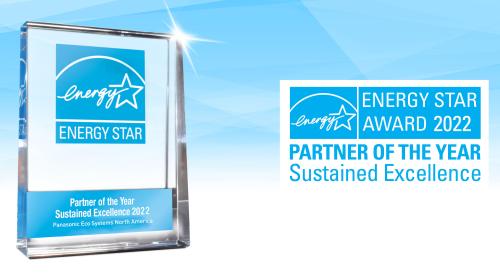|
During the energy crunch that began in the spring of 2001, consumers saw their monthly utility bills increase by leaps and bounds within months. As winter approached, Easterners dreaded the potential rise of furnace oil prices, while homeowners in the South and West braced for electricity costs not seen in more than a decade. And as a direct result of shortages and price hikes, California saw its enormous budget surplus evaporate quickly, with expenditures of more than $6 billion for power purchases.
To public officials and consumers, it was a stark reminder that energy is pivotal to both the health of the economy and the family budget. While the latest crisis has subsided, it renewed attention and interest in the Environmental Protection Agency’s well-regarded Energy Star program, especially Energy Star-labeled homes.
The EPA introduced the Energy Star program in 1992 as a voluntary labeling program to identify and promote energy-efficient products as a way to reduce carbon dioxide emissions. In 1995, Energy Star was expanded to cover new homes, residential heating and cooling equipment, major appliances, office equipment, lighting and consumer electronics.
| Sustainability: Energy Star, Sam Rashkin |
Despite a slow start during the highflying mid-’90s, the awareness and acceptance of Energy Star in the new home industry have increased rapidly during the past few years. Today, 30% of the nation’s largest home builders offer compliant models. Among them are Beazer Homes, Cambridge Homes, Centex, D.R. Horton, Emerald Homes, Hovnanian Enterprises, KB Home, John Laing Homes, Newmark Homes, Pardee Homes, Pulte Homes, Shea Homes and U.S. Home. Many regional and boutique builders participate as well.
Among the milestones Energy Star reached in 2001:
- 45,000 Energy Star-labeled new homes built
- 10-25% penetration in major markets
- 50 utility companies now participating
- 60 manufactured housing plants adopting standards
- Increased recognition from home building industry award programs
The simple reason for the exponential growth in the number of Energy Star-labeled homes is that it’s good business. Sam Rashkin, national director of Energy Star for Homes, says, “The laws of physics dictate that energy-efficient homes perform better, while energy savings reduce ownership costs every month. Energy Star completes the process by allowing builders to get credit for being truly energy-efficient with a trusted government-backed label.” Two such builders are Pardee Homes, based in Los Angeles, and Pulte Homes, based in Bloomfield Hills, Mich.
Pardee Homes has broadened its focus on energy efficiency by making Energy Star one element of a broader program it calls Living Smart, an array of standards and options to be introduced in a high-end design line in San Diego and eventually incorporated at other price points. “We saw adopting the Energy Star requirements as an opportunity to create a consumer-friendly branding program that provides home buyers with greater control over environmental, health and safety, and energy-conservation issues related to their home,” says Joyce Mason, Pardee’s vice president of marketing. “Now we’re moving further into environmentally friendly choices for our buyers.”
Richard Obernesser, director of sales and marketing for Pulte’s Phoenix division, says the company has practiced energy-efficient home construction for several years and is now an Energy Star partner. “We are contributing to the long-term satisfaction of the homeowner because of the savings and energy efficiency they will notice when they open their monthly utility bills,” he explains. “The Energy Star designation allows us to differentiate ourselves from the competition. Customers have a reputable source that can validate the importance of energy-efficient features that are included in a Pulte home.”
Validation from the industry has followed. The NAHB Research Center recognized Pulte Homes with its 2001 Energy Value Housing Award.
To qualify as an Energy Star-labeled home, the design, materials and construction of the home must be verified to use 30% less energy for heating, cooling and water heating than a home built to the Model Energy Code, the energy standard used in most states. Both new and existing homes can qualify for the Energy Star designation if they receive a Home Energy Rating System score of 86 or better. The HERS rating is an objective, standardized evaluation of the energy efficiency of a home compared with a simulated reference house of the same size and shape that meets minimum energy code requirements.
According to the EPA’s findings from tracking new homes built to Energy Star requirements, several tangible benefits are realized by both builder and homeowner:
- Lower monthly utility costs for the homeowner
- Better marketability as a distinction in a competitive marketplace
- Special mortgage and other financing opportunities for the buyer from participating Energy Star lenders
- Preferential permitting treatment to builders from some local governments, including San Diego County, for energy-efficient new home developments
- Rebates and reimbursements to the consumer from utilities
- Higher resale value thanks to increased public awareness of the benefits of energy efficiency
The environmental rewards of energy conservation speak for themselves. The EPA estimates that last year alone, the Energy Star initiative helped save enough energy to power 10 million homes and reduce air pollution equivalent to that from 10 million cars, while also saving consumers $5 billion on their energy bills.
As resources become scarcer, these rewards will only become more valuable to buyers and builders. For more about the Energy Star program, including resources available to builders from the EPA, call 888/STAR-YES (782-7937) or visit www.energystar.gov.












